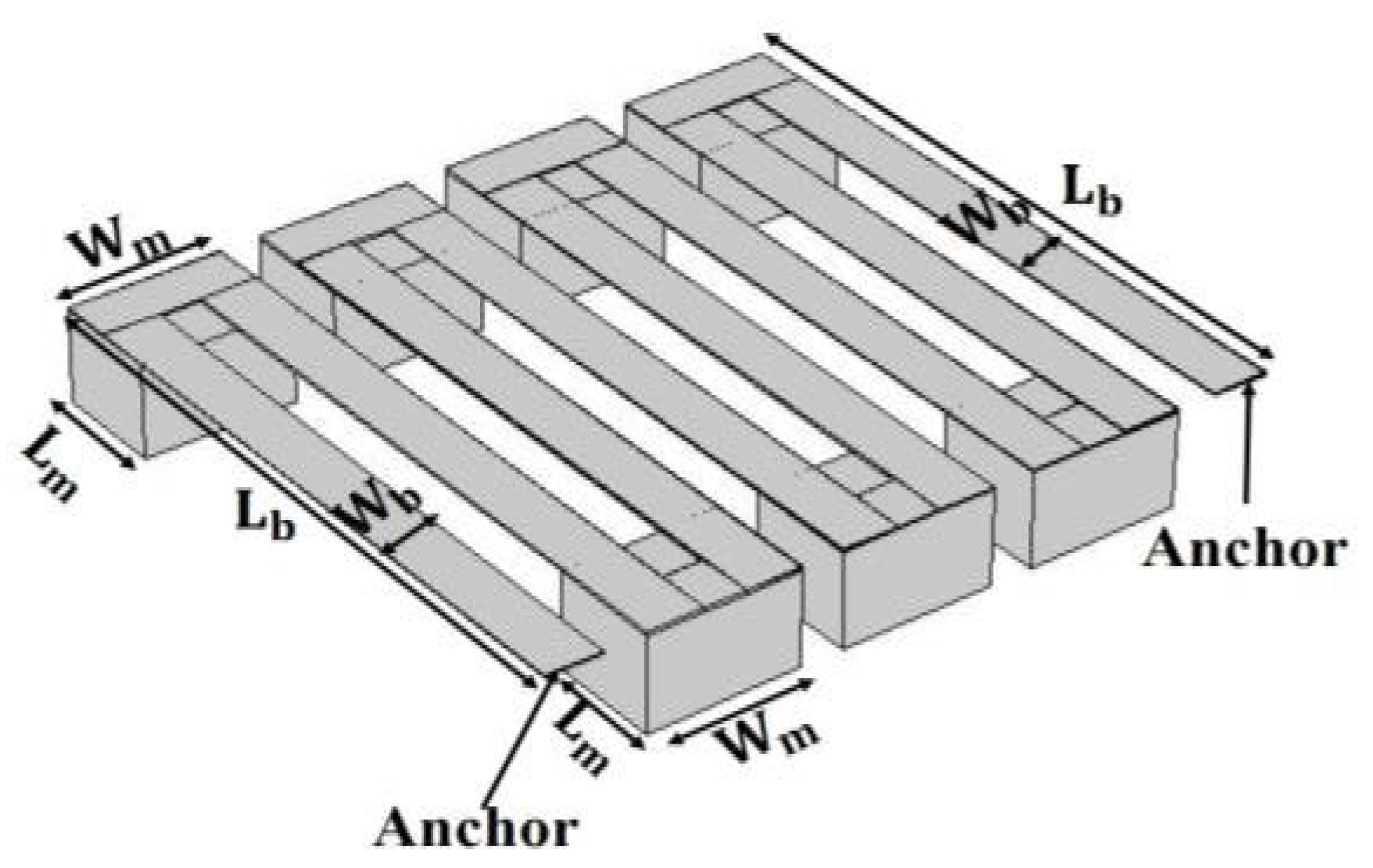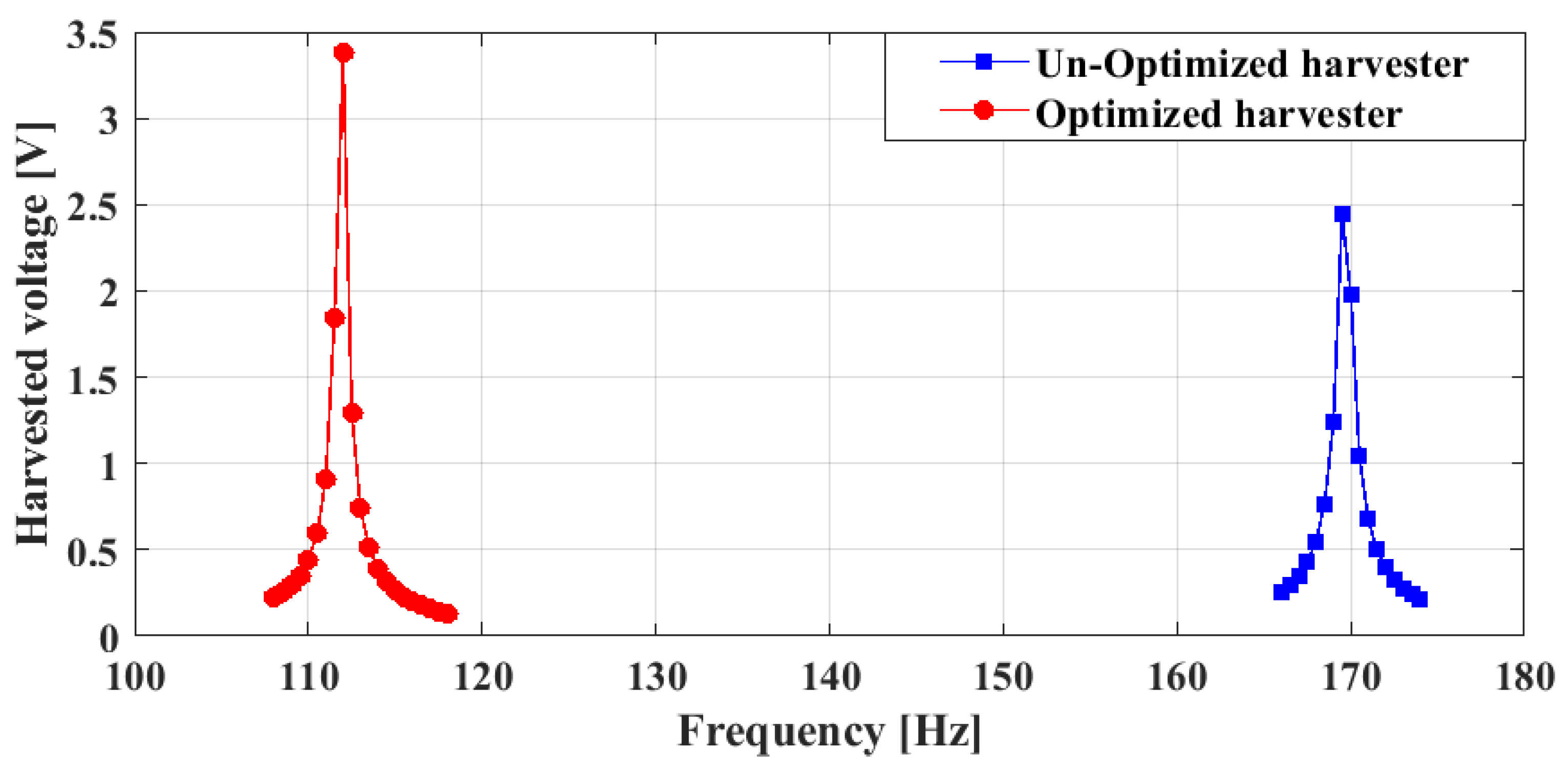Design and Optimization of a Low-Resonant-Frequency Piezoelectric MEMS Energy Harvester Based on Artificial Intelligence †
Abstract
:1. Introduction
2. Low-Resonant-Frequency Piezoelectric MEMS Harvester
3. AI-Based Optimization Methodology
4. Results and Discussion
5. Conclusions
Acknowledgments
Conflicts of Interest
References
- Nabavi, S.; Zhang, L. Portable wind energy harvesters for low-power applications: A survey. Sensors 2016, 16, 1101. [Google Scholar] [CrossRef] [PubMed]
- Kim, M.-O.; Pyo, S.; Oh, Y.; Kang, Y.; Cho, K.-H.; Choi, J.; Kim, J. Flexible and multi-directional piezoelectric energy harvester for self-powered human motion sensor. Smart Mater. Struct. 2018, 27, 035001. [Google Scholar] [CrossRef]
- Wang, Q.; Lu, Y.; Mishin, S.; Oshmyansky, Y.; Horsley, D.A. Design, fabrication, and characterization of scandium aluminum nitride-based piezoelectric micromachined ultrasonic transducers. J. Microelectromech. Syst. 2017, 26, 1132–1139. [Google Scholar] [CrossRef]
- Roundy, S.; Wright, P.K. A piezoelectric vibration based generator for wireless electronics. Smart Mater. Struct. 2004, 13, 1131. [Google Scholar] [CrossRef]
- Roundy, S.; Wright, P.K.; Rabaey, J. A study of low level vibrations as a power source for wireless sensor nodes. Comput. Commun. 2003, 26, 1131–1144. [Google Scholar] [CrossRef]
- Nabavi, S.; Zhang, L. Design and optimization of wideband multimode piezoelectric MEMS vibration energy harvesters. Proceedings 2017, 1, 586. [Google Scholar] [CrossRef]
- Song, H.-C.; Kumar, P.; Maurya, D.; Kang, M.-G.; Reynolds, W.T.; Jeong, D.-Y.; Kang, C.-Y.; Priya, S. Ultra-Low Resonant Piezoelectric MEMS Energy Harvester With High Power Density. J. Microelectromech. Syst. 2017, 26, 1226–1234. [Google Scholar] [CrossRef]
- Nabavi, S.; Zhang, L. Design and optimization of MEMS piezoelectric energy harvesters for improved efficiency. In Proceedings of the IEEE SENSORS, Glasgow, UK, 29 October–1 November 2017; pp. 1–3. [Google Scholar]
- Nabavi, S.; Zhang, L. MEMS piezoelectric energy harvester design and optimization based on Genetic Algorithm. In Proceedings of the IEEE International Ultrasonics Symposium (IUS), Tours, France, 18–21 September 2016; pp. 1–4. [Google Scholar]
- Nabavi, S.; Zhang, L. Design and Optimization of Piezoelectric MEMS Vibration Energy Harvesters Based on Genetic Algorithm. IEEE Sens. J. 2017, 17, 7372–7382. [Google Scholar] [CrossRef]



| Parameter | Lb [μm] | wb [μm] | Lm [μm] | wm [μm] | Freq. (DNN) [Hz] | Freq. (FEM) [HZ] | Voltage (DNN) [V] | Voltage (FEM) [V] |
|---|---|---|---|---|---|---|---|---|
| Range | (1,550,3050) | (150,250) | (500,1000) | (600,614) | - | - | - | - |
| un-opt | 2300 | 200 | 750 | 607 | 162 | 169 | 2.7 | 2.5 |
| opt | 2945 | 216 | 907 | 609 | 105 | 110.5 | 3.5 | 3.25 |
Publisher’s Note: MDPI stays neutral with regard to jurisdictional claims in published maps and institutional affiliations. |
© 2018 by the authors. Licensee MDPI, Basel, Switzerland. This article is an open access article distributed under the terms and conditions of the Creative Commons Attribution (CC BY) license (https://creativecommons.org/licenses/by/4.0/).
Share and Cite
Nabavi, S.; Zhang, L. Design and Optimization of a Low-Resonant-Frequency Piezoelectric MEMS Energy Harvester Based on Artificial Intelligence . Proceedings 2018, 2, 930. https://doi.org/10.3390/proceedings2130930
Nabavi S, Zhang L. Design and Optimization of a Low-Resonant-Frequency Piezoelectric MEMS Energy Harvester Based on Artificial Intelligence . Proceedings. 2018; 2(13):930. https://doi.org/10.3390/proceedings2130930
Chicago/Turabian StyleNabavi, Seyedfakhreddin, and Lihong Zhang. 2018. "Design and Optimization of a Low-Resonant-Frequency Piezoelectric MEMS Energy Harvester Based on Artificial Intelligence " Proceedings 2, no. 13: 930. https://doi.org/10.3390/proceedings2130930
APA StyleNabavi, S., & Zhang, L. (2018). Design and Optimization of a Low-Resonant-Frequency Piezoelectric MEMS Energy Harvester Based on Artificial Intelligence . Proceedings, 2(13), 930. https://doi.org/10.3390/proceedings2130930





